engine Oldsmobile Aurora 1998 s User Guide
[x] Cancel search | Manufacturer: OLDSMOBILE, Model Year: 1998, Model line: Aurora, Model: Oldsmobile Aurora 1998Pages: 380, PDF Size: 19.75 MB
Page 89 of 380
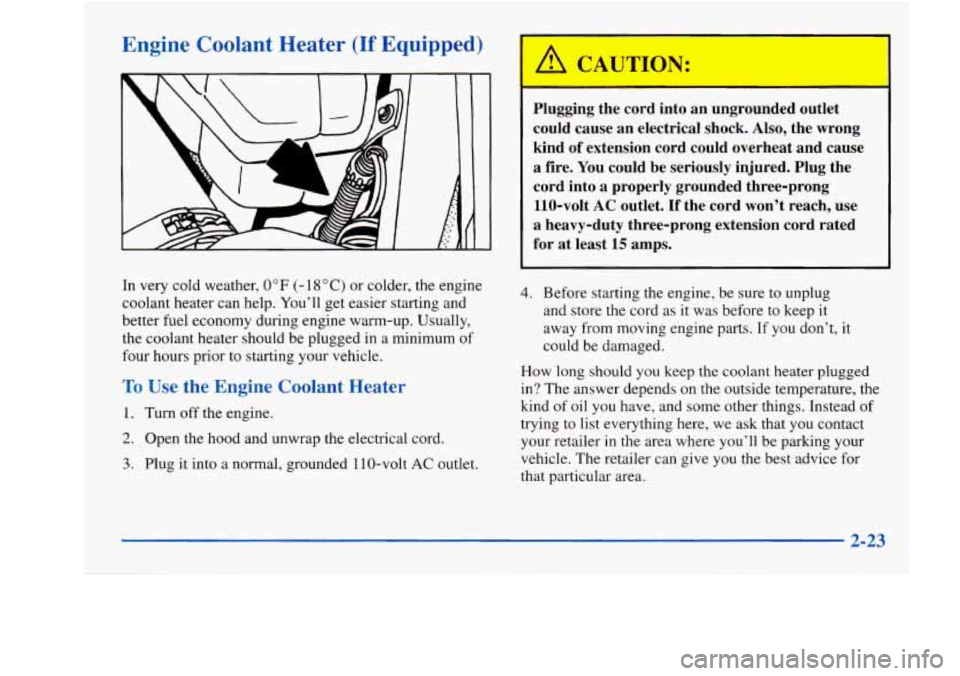
Engine Coolant Heater (If Equipped)
Plugging the cord into an ungrounded outlet
could cause an electrical shock. Also, the wrong
kind
of extension cord could overheat and cause
a fire. You could be seriously injured. Plug the
cord into
a properly grounded three-prong
110-volt
AC outlet. If the cord won’t reach, use
a heavy-duty three-prong extension cord rated
for
at least 15 amps.
In very cold weather,
0 OF (- 18 O C) or colder, the engine
coolant heater can help. You’ll get easier starting and
better fuel economy during engine warm-up. Usually,
the coolant heater should be plugged in a minimum of
four hours prior to starting your vehicle.
To Use the Engine Coolant Heater
1. Turn off the engine.
2. Open the hood and unwrap the electrical cord.
3. Plug it into a normal, grounded 1 10-volt AC outlet.
4. Before starting the engine, be sure to unplug
and store the cord as it was before to keep it
away from moving engine parts. If you don’t, it
could be damaged.
How long should you keep the coolant heater plugged
in? The answer depends on the outside temperature, the
kind of oil you have, and some other things. Instead
of
trying to list everything here, we ask that you contact
your retailer
in the area where you’ll be parking your
vehicle.
The retailer can give you the best advice for
that particular area.
2-23
Page 90 of 380
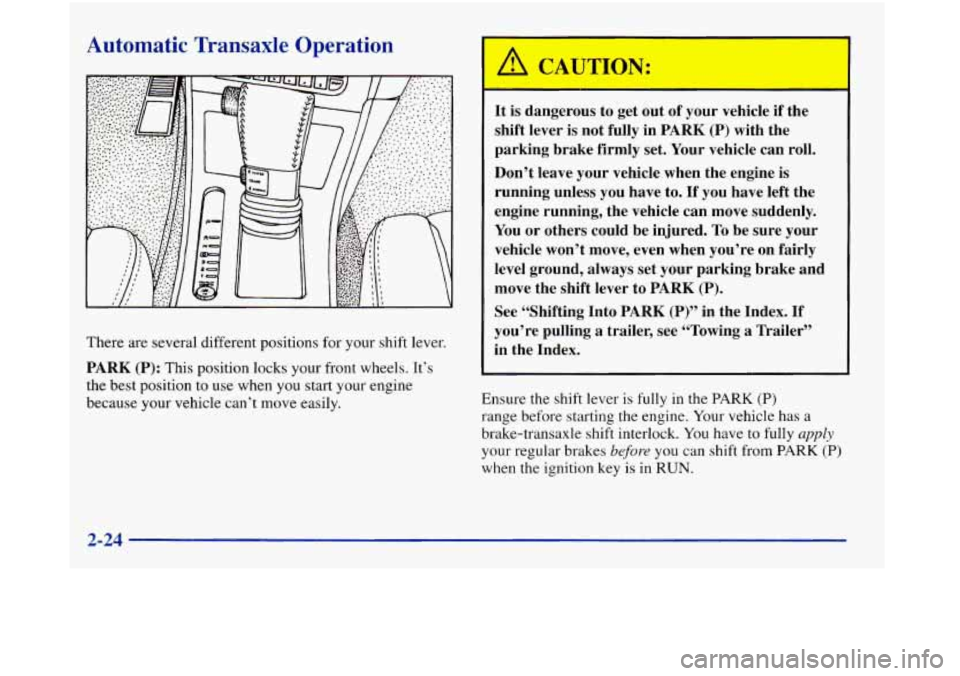
Automatic Transaxle Operation
There are several different positions for your shift lever.
PARK (P): This position locks your front wheels. It’s
the best position
to use when you start your engine
because your vehicle can’t move easily. It
is dangerous to get
out of your vehicle if the
shift lever is not fully in
PARK (P) with the
parking brake firmly set. Your vehicle can roll.
Don’t leave your vehicle when the engine is
running unless you have
to. If you have left the
engine running, the vehicle can move suddenly.
You
or others could be injured. To be sure your
vehicle won’t move, even when you’re on fairly
level ground,
always set your parking brake and
move the shift lever to
PARK (P).
See “Shifting Into PARK (P)” in the Index. If
you’re pulling a trailer, see “Towing a Trailer’’
in the Index.
Ensure the shift lever
is fully in the PARK (P)
range before starting the engine. Your vehicle has a
brake-transaxle shift interlock. You have to fully
apply
your regular brakes bcfore you can shift from PARK (P)
when the ignition key is in RUN.
2-24
Page 91 of 380

REVERSE (R): Use this gear to back up.
I NOTICE:
Shifting to REVERSE (R) while your vehicle is
moving forward could damage your transaxle. Shift to
REVERSE (R) only after your vehicle
is stopped.
To rock your vehicle back and forth to get out of snow,
ice or sand without damaging your transaxle, see
“Stuck: In Sand, Mud, Ice or Snow” in the Index.
NEUTRAL
(N): In this position, your engine doesn’t
connect with the wheels.
To restart when you’re
already moving, use
NEUTRAL (N) only. Also, use
NEUTRAL (N) when your vehicle is being towed. Shifting out
of PARK
(P) or NEU‘l’RAL (N) while
your engine is “racing” (running at high speed) is
dangerous. Unless your foot
is firmly on the
brake pedal, your vehicle could move very rapidly. You could lose control and hit people
or
objects. Don’t shift out of PARK (P) or
NEUTRAL (N) while your engine is racing.
I NOTICE:
Damage to your transaxle caused by shifting out
of PARK (P) or NEUTRAL (N) with the engine
racing isn’t covered by your warranty.
2-25
Page 93 of 380

Selectable Shift
This button lets you change from a normal driving mode
to a power mode. For general driving conditions, use the
normal mode.
Parking Brake
Press the button on your shift lever so that it’s either in
the NORMAL or the
POWER position. When it’s in the
NORMAL position, the line on the button will be
showing. When in POWER, the line is not showing.
In the NORMAL position, the transaxle shifts at lower
engine speeds. For increased performance, you may
choose the POWER mode.
Setting the parking brake: Hold the regular brake
pedal down with your right foot. Push down the parking
brake pedal with your left foot.
If the ignition is on, the
parking brake indicator light will come on.
Page 94 of 380
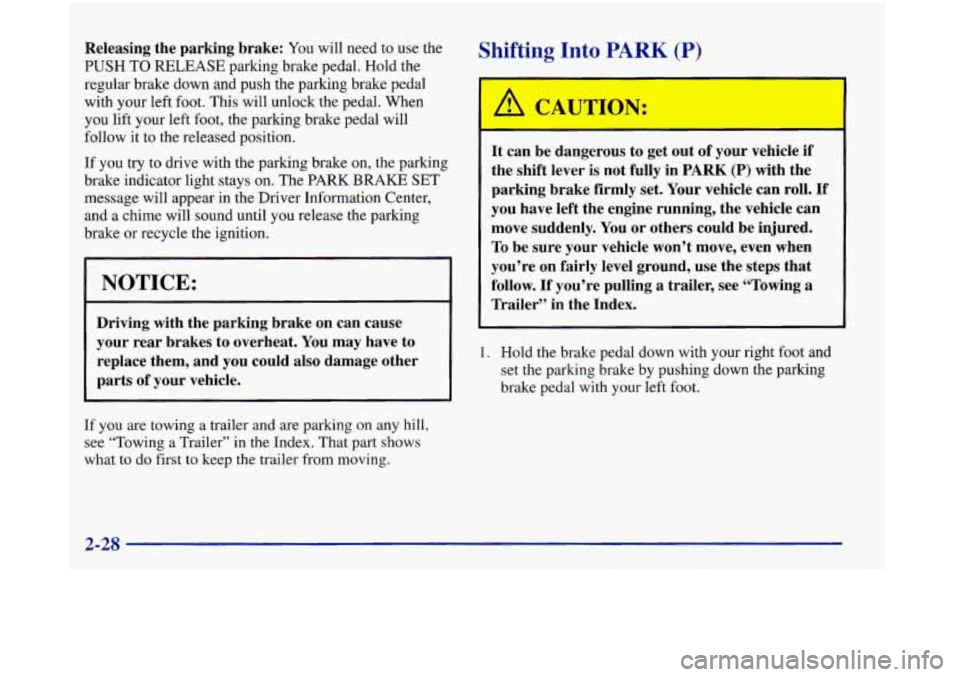
Releasing the parking brake: You will need to use the
PUSH TO RELEASE parking brake pedal. Hold the
regular brake down and push the parking brake pedal
with your left foot. This will unlock the pedal. When
you lift your left foot, the parking brake pedal will
follow
it to the released position.
If you try to drive with the parking brake on, the parking
brake indicator light stays
on. The PARK BRAKE SET
message will appear in the Driver Information Center,
and
a chime will sound until you release the parking
brake or recycle the ignition.
NOTICE:
Shifting Into PARK (P)
Driving with the parking brake on can cause
your rear brakes to overheat. You may have to
replace them, and you could also damage other
parts of your vehicle.
1
If you are towing a trailer and are parking on any hill,
see “Towing a Trailer” in the Index. That part
shows
what to do first to keep the trailer from moving.
It can be dangerous to get out of your vehicle if
the shift lever is not fully in PARK (P) with the
parking brake firmly set.
Your vehicle can roll. If
you have left the engine running, the vehicle can
move suddenly. You or others could be injured.
To be sure your vehicle won’t move, even when
you’re on fairly level ground, use the steps that
follow. If you’re pulling a trailer, see “Towing a
Trailer” in the Index.
1. Hold the brake pedal down with your right foot and
set the parking brake by pushing down the parking
brake pedal with your left foot.
2-28
Page 95 of 380

2. Move the shift lever into PARK (P) as follows:
Hold in the button on the lever.
Push the lever all the way down toward the front
of your vehicle.
3. Turn the ignition key to LOCK.
4. Remove the key and take it with you. If you can
leave your vehicle with the ignition key in your
hand, your vehicle is in
PARK (P).
Leaving Your Vehicle With the
Engine Running
It can be dangerous to leave your vehicle with the
engine running. Your vehicle could move
suddenly if the shift lever is not fully in
PARK (P)
with the parking brake firmly set. And, if you
leave the vehicle with the engine running, it could overheat and even catch fire. You or others could
be injured. Don’t leave your vehicle with the
engine running unless you have to.
If you have to leave your vehicle with the engine
running, be sure your vehicle is
in PARK (P) and your
parking brake is firmly set before you leave
it. After
you’ve moved the shift lever into PARK (P), hold the
regular brake pedal down. Then,
see if you can move the
shift lever away from PARK (P) without first pushing
the button.
If you can, it means the shift lever wasn’t fully locked
into PARK (P).
Page 97 of 380

Parking Over Things That Burn Engine
Exhaust
I
Things that can burn could touch hot exhaust
parts under your vehicle and ignite. Don’t park
over papers, leaves, dry grass
or other things that
can burn. Engine
exhaust can kill. It contains the gas
carbon monoxide
(CO), which you can’t see or
smell. It can cause unconsciousness and death.
You might have exhaust coming in if:
Your exhaust system sounds strange
0 Your vehicle gets rusty underneath.
0 Your vehicle was damaged in a collision.
Your vehicle was damaged when driving over
high points on the road or over road debris.
Repairs weren’t done correctly.
0 Your vehicle or exhaust system had been
If you ever suspect exhaust is coming into
your vehicle:
0 Drive it only with all the windows down to
0 Have your vehicle fixed immediately.
or
different.
modified improperly. blow out any
CO; and
Page 99 of 380
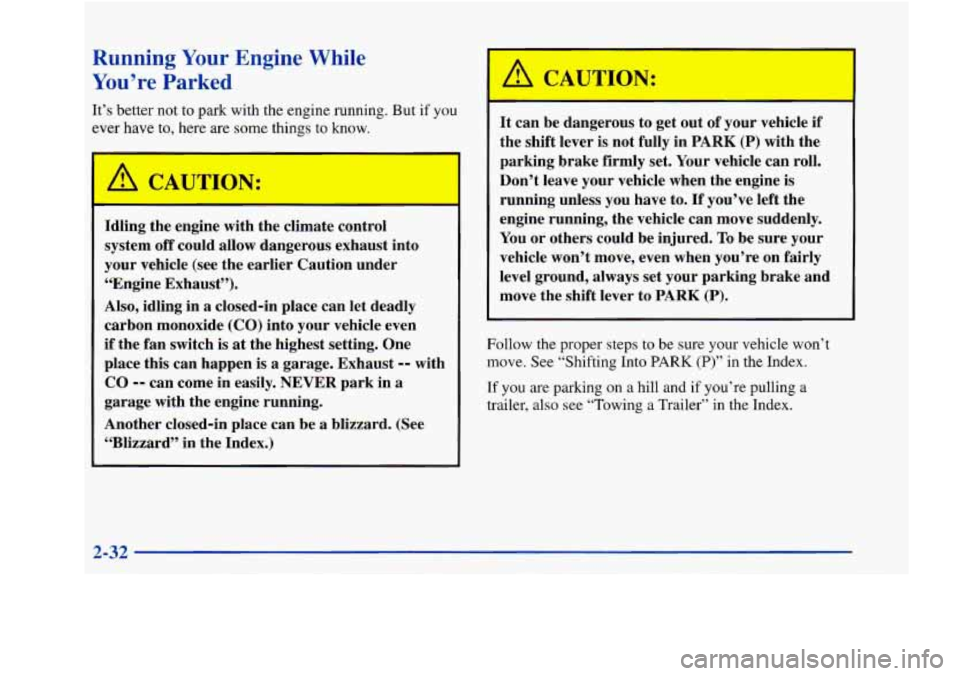
Running Your Engine While
You’re
P-_- I-ed
It’s better not to park with the engine running. But if you
ever have to, here are
some things to know.
A
/L CA 7ON:
Idling the engine with the climate control
system
off could allow dangerous exhaust into
your vehicle (see the earlier Caution under
“Engine Exhaust”).
Also, idling in
a closed-in place can let deadly
carbon monoxide
(CO) into your vehicle even
if the fan switch is at the highest setting. One
place this can happen is
a garage. Exhaust -- with
CO -- can come in easily. NEVER park in a
garage with the engine running.
Another closed-in place can be a blizzard. (See
“Blizzard” in the Index.)
-
It can be dangerous to get out of your vehicle if
the shift lever is not fully in PARK (P) with the
parking brake firmly set. Your vehicle can roll.
Don’t leave your vehicle when the engine is
running unless you have to.
If you’ve left the
engine running, the vehicle can move suddenly.
You or others could be injured.
To be sure your
vehicle won’t move, even when you’re on fairly
level ground, always set your parking brake and
move the shift lever to PARK
(P).
Follow the proper steps to be sure your vehicle won’t
move. See “Shifting Into
PARK (P)” in the Index.
If you are parking on a hill and if you’re pulling a
trailer, also see “Towing a Trailer’’ in the Index.
Page 110 of 380
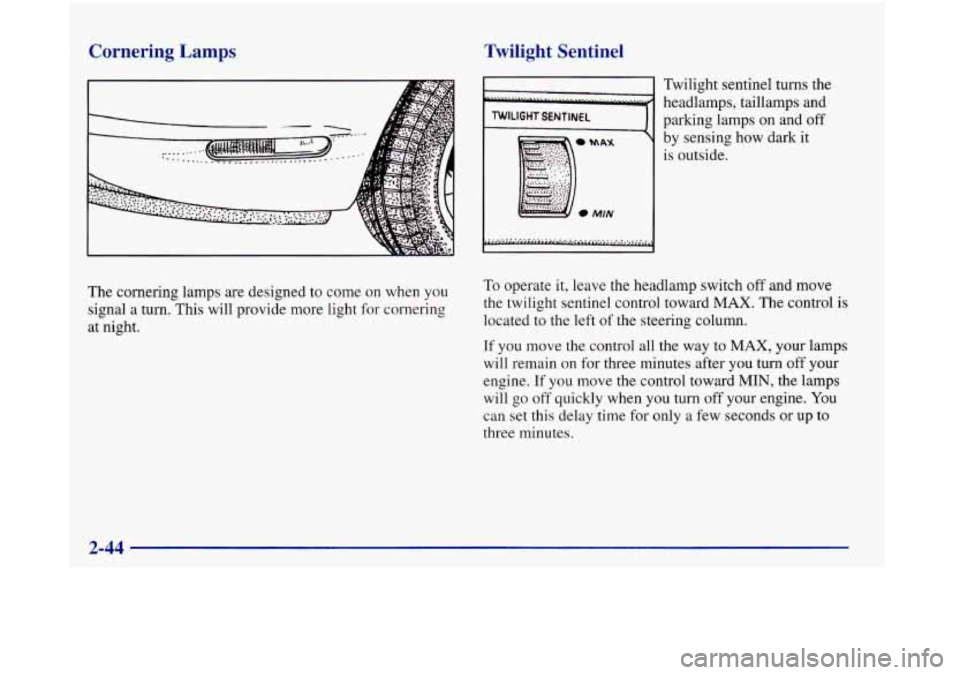
Cornering Lamps
The cornering lamps are designed to come on when you
signal a turn. This will provide more light for cornering
at night.
Twilight Sentinel
Twilight sentinel turns the
headlamps, taillamps and
TWILIGHT SfNTlNEL
II parking famps on and off
by sensing how dark it
is outside.
To operate it, leave the headlamp switch off and move
the twilight sentinel control toward MAX. The control is
located to the left of the steering column.
If you move the control all the way to MAX, your lamps
will remain on for three minutes after you turn
off your
engine. If you move the control toward MIN, the lamps
will go off quickly when you turn off your engine. You
can set this delay time for only a few seconds
or up to
three minutes.
Page 123 of 380

This device complies with Part 15 of the FCC Rules.
Operation is subject to the following two conditions:
(1) this device may not cause harmful interference,
and
(2) this device must accept any interference
received, including interference that may cause
undesired operation.
This device complies with
RSS-210 of Industry Canada.
Operation is subject to the following two conditions:
(1) this device may not cause interference, and (2) this
device must accept any interference, including
interference that may cause undesired operation
of
the device.
Changes and modifications to this system by other than
an authorized service facility could void authorization
to use this equipment.
Programming the Transmitter
Do not use the universal transmitter with any garage
door opener that does not have the “stop and reverse”
safety feature. This includes any garage door opener
model manufactured before April
1, 1982.
rse sure that people and objects are clear of the garage
door you are programming. Your
vehicle’s engine should be turned off while
programming your transmitter. Follow these steps to
program up to three channels:
1. If you have previously programmed a universal
transmitter channel, proceed to Step
2. Otherwise,
hold down the two outside buttons on the universal
transmitter until the red light begins to flash rapidly
(approximately
20 seconds). Then release the
buttons. This procedure initializes the memory and
erases any previous settings for all three channels.
2. Hold the end of your hand-held transmitter against
the bottom surface of the universal transmitter
so
that you can still see the red light.
3. Decide which one of the three channels you want to
program. Using both hands, press the hand-held
transmitter button and the desired button on the
universal transmitter. Continue to hold both buttons
through Step
4.
4. Hold down both buttons until you see the red light
on the universal transmitter flash slowly then
rapidly. The rapid flashing, which could take up
to
90 seconds, indicates that the universal transmitter
has been programmed. Release both buttons
three seconds after the light starts to flash rapidly.
2-57